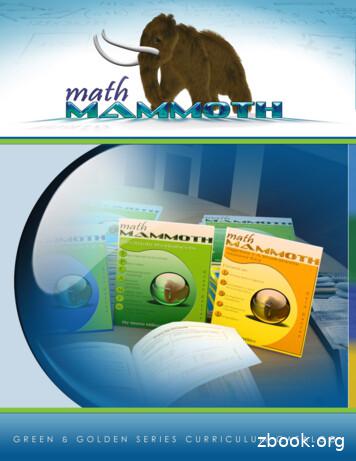LEARNING WORKSHEETS SEVENTH GRADE
LEARNING WORKSHEETSSEVENTH GRADENAME:snoitreneg laroC/ snoitareneg fo gniOur Mission: To foster understanding, wonder, and respect for Hawaii’s marine life.E paipai i ka ʻiʻini e ulu ai ka ʻike kuʻuna Hawaiʻi e ola mau ka nohona moana.y 9am-5pm MauiOcOpen DaileanCenter. c o m 192 Mā‘a l a000ea Rd. Wa i l u k u , H I 9 6 7 9 3 8 0 8 . 2 7 0 . 7k
Interdependent RelationshipsA food web (or chain) shows how each living thing gets its food. Some animals eatplants and some animals eat other animals. For example, a simple food chain linksplants, cows (that eat plants), and humans (that eat cows). Each link in this chain isfood for the next link. A food chain always starts with plant life and ends with ananimal.Plants are called producers (they are also autotrophs) because they are able to uselight energy from the sun to produce food (sugar) from carbon dioxide and water.Animals cannot make their own food so they must eat plants and/or other animals.They are called consumers (they are also heterotrophs). There are three groups ofconsumers. Animals that eat only plants are called herbivores. Animals that eat other animals are called carnivores. Animals and people who eat both animals and plants are called omnivores.Decomposers (bacteria and fungi) feed on decaying matter. These decomposersspeed up the decaying process that releases minerals back into the food chain forabsorption by plants as nutrients.Do you know why there are more herbivores than carnivores?In a food chain, energy is passed from one link to another. When a herbivore eats,only a fraction of the energy (that it gets from the plant food) becomes new bodymass; the rest of the energy is lost as waste or used up (by the herbivore as it moves).Likewise, when a carnivore eats another animal, only a portion of the energy from theanimal food is stored in its tissues. In other words, organisms along a food chain passon much less energy (in the form of body mass) than they receive.7TH GRADE 1
Food WebsDraw a food web using the following organisms:Sea Lettuce (limu) – green algaSea Hare (kualakai) – feeds on algaeCauliflower coral (ko‘a) – a hard coral with zooxanthellaeOrange cup coral – hard coral without zooxanthellaeTiger sharks – feeds on fish and other animalsYellowfin tuna (ahi) - eats fish, squid and crustaceansAchilles tang (paku‘iku‘i) - eats green algaeSpiny lobster – crustacean, scavenger, eats anything!Humans – eats a varied diet of fish, meat and vegetablesPhytoplankton – microscopic green algaeZooplankton – feeds on phytoplankton7TH GRADE 2
Create A Food WebCreate a marine food web. Be sure to begin each food web with a Producer (plant) and endeach food web with a Decomposer (such as shrimp, crabs, or marine bacteria).Each food web should haveat least four levels.Label the Producers (P), Consumers (C), and Decomposers (D) in your food chain.Why do all food webs begin with a plant?What is the role of Consumers in a food web?Why are Decomposers so important in a food web?How does energy move through food webs?.7TH GRADE 3
InterdependenceWe just examined food chains and how animals depend on each other to gain nutrientsand energy. Keep in mind how animals interact with and depend on other organisms fortheir own survival.Visit our Open Ocean Exhibit and observe some of the apex predators, like the sharks.Explain the importance of a predator in a biological community.Give an example of two animals you observed at the Maui Ocean Center that havebenefited from each other? What were they doing to help each other survive?.Why does a parasite depend on other animals?.7TH GRADE 4
sSymbiotic Relationship& Energy TransferCoral reefs play an important role in Hawaii’s marine ecosystem. A diverse number of organisms relyon coral reefs for food as well as shelter. Symbiotic relationships are observed in many marine organisms.Figure 2. illustrates the relationship between coral organisms and zooxanthellae algae. Explore our LivingReef building and answer the following questions about energy transfer between these two organisms.1. Describe how each organism benefits from this symbiotic relationship between coral and the algae?2. What source of energy does the symbiotic algae use to produce the food and oxygen for the polyp?3. Roughly what % of food does the zooxanthellae provide to coral?4. Coral secretes a hard skeleton made out of limestone or calcium carbonate. What contributes to theformation of this structure?7TH GRADE 5
Coral Reef DwellersFind two animals living in different sections of The Living Reef, Surge Zone and Deep Reef.Draw these animals and write where you're likely to see them and why.Animal #1:Animal #2:Marine animals live in different places, some prefer the surge zone with lots ofwaves, other the deep reef with very few waves.7TH GRADE 6
Fish AdaptationsBACKGROUNDThe tropical oceans of the world are home to fish, mammals, and birds aswell as a myriad of invertebrates. Many beautiful and fragile animals haveadapted to the warm waters of coral reefs. Because the reefs offer natural protectiontomany of the fish, many interesting adaptations have taken place. The result is someof themost bizarre and beautiful creatures found in the sea.ADAPTATIONSWhy do you think the Frogfish looks the way it does? Adaptations appear over timebecause certain shapes and colors create camouflage which protect an organismfrom its predators. Looking like a piece of sponge or coral can help the Frogfishavoid being another animal's lunch!ACTIVITYEach student will choose one fish from any exhibit. They will write down its name,observe the animal in its environment for at least 15 minutes and record theirobservations on the worksheet. They will take their information and compile it ina short report.ASSESSMENTCompleted reports will give specific details about the behavior and characteristicsof the individual fish and how it survives in its environment.RESOURCESOn the next two pages you will find some common adaptations in fish and how theyuse these adaptations to survive in their environment.7TH GRADE 7
Adaptations in Fish7TH GRADE 8
Adaptations in Fish7TH GRADE 9
Adaptations in FishFollow A FishSketch your animal. Be sure to include unusual markings.Common Name:Hawaiian Name:APPEARANCE:What does it look like?Color:Body Shape:Markings:Size:Texture:Fins:7TH GRADE 10
Adaptations in FishFollow A FishBehavior– How does your fish behave?Swimming pattern:Does your fish have any defense mechanisms?Does it travel alone or with others?Where in the tank does it go?Notes:Conclusion:How do this fish's characteristics enable it to live in its environment?7TH GRADE 11
7TH GRADE 1 A food web (or chain) shows how each living thing gets its food. Some animals eat plants and some animals eat other animals. For example, a simple food chain links plants, cows (that eat plants), and humans (that eat cows). Each link in this chain is food for the next link. A
Teacher of Grade 7 Maths What do you know about a student in your class? . Grade 7 Maths. University Grade 12 Grade 11 Grade 10 Grade 9 Grade 8 Grade 7 Grade 6 Grade 5 Grade 4 Grade 3 Grade 2 Grade 1 Primary. University Grade 12 Grade 11 Grade 10 Grade 9 Grade 8 Grade 7 Grade 6 Grade 5 . Learning Skill
Grade 3 Worksheets Grade 4 Worksheetts Grade 5 Worksheets Grade 6 Worksheets Grade 7/8 Worksheets (pre-algebra) Algebra 1 Worksheets 4 4 5 5 6 6 Math Mammoth Green Series Measuring Multiplication & Division Numbers & Operations Fractions Decimals Geometry Integers Ratio, Proportion & Percent Statistics 7 7 7 8 8 8 9 9 9
Grade 4 NJSLA-ELA were used to create the Grade 5 ELA Start Strong Assessment. Table 1 illustrates these alignments. Table 1: Grade and Content Alignment . Content Area Grade/Course in School Year 2021 – 2022 Content of the Assessment ELA Grade 4 Grade 5 Grade 6 Grade 7 Grade 8 Grade 9 Grade 10 Grade 3 Grade 4 Grade 5 Grade 6 Grade 7 Grade 8
“Seventh Grade” Reading RWBAT: Analyze the short story “Seventh Grade” by Gary Soto through read-alouds, discussions, and annotations. 2-3 class periods “Seventh Grade” Mini-Project RWBAT: Translate knowledge of the short story “Seventh Grade” by
Math Course Progression 7th Grade Math 6th Grade Math 5th Grade Math 8th Grade Math Algebra I ELEMENTARY 6th Grade Year 7th Grade Year 8th Grade Year Algebra I 9 th Grade Year Honors 7th Grade Adv. Math 6th Grade Adv. Math 5th Grade Math 6th Grade Year 7th Grade Year 8th Grade Year th Grade Year ELEMENTARY Geome
math exercises . and include Grade 6 Math Worksheets, Grade 7 Math Worksheets, Grade 8 . Apr 6, 2020 — Download our free Mathematics worksheets for the 8th Grade test. . 5 Full-Length Common Core Grade 8 Math Practice Tests: The Practice You Need to Ace the Common Cor
order of operations worksheets with answers. order of operations worksheets with answers, printable order of operations worksheets with answers, order of operations word problems worksheets with answers grade 5, order of operations with decimals worksheets with answers, order of operations
7 Grade 1 13 Grade 2 18 Grade 3 23 Grade 4 28 Grade 5 33 Grade 6 38 Elementary Spanish. 29 Secondary. 39 Grade 7 43 Grade 8 46 Grade 9 49 Grade 10 53 Grade 11 57 Grade 12 62 Electives. Contents. Textbook used with Online Textbook used with DVD. Teacher Edition & Student Books. Color Key























